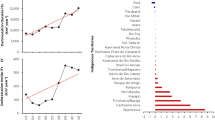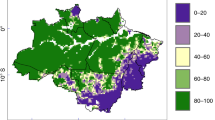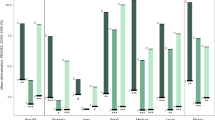Abstract
Conflicts between forest conservation and socio-economic development in the Brazilian Legal Amazon (BLA) have persisted for years but the effects of Indigenous territory (ITs) and protected area (PAs) status on deforestation there remain unclear. To address this issue, we analysed time-series satellite images and qualified annual forest area in the BLA under different governance and management regimes. Between 2000 and 2021, areas classified as ITs or PAs increased to cover 52% of forested areas in the BLA while accounting for only 5% of net forest loss and 12% of gross forest loss. In the years (2003–2021) after establishment, gross forest loss fell 48% in PAs subject to ‘strict protection’ and 11% in PAs subject to ‘sustainable use’. However, from 2018 to 2021 the percentage rate of annual gross forest loss in ITs/PAs was twice that of non-designated areas. Our findings reveal the vital role of, and substantial progress achieved by, ITs and PAs in Amazonian forest conservation as well as the dangers of recent weakening of Brazil’s forest policies.
This is a preview of subscription content, access via your institution
Access options
Access Nature and 54 other Nature Portfolio journals
Get Nature+, our best-value online-access subscription
$32.99 / 30 days
cancel any time
Subscribe to this journal
Receive 12 digital issues and online access to articles
$119.00 per year
only $9.92 per issue
Buy this article
- Purchase on SpringerLink
- Instant access to full article PDF
Prices may be subject to local taxes which are calculated during checkout






Similar content being viewed by others
Data availability
MODIS evergreen forest maps are available at Figshare: https://figshare.com/articles/dataset/Annual_evergreen_forest_cover_maps_in_the_Brazilian_Amazon_from_2000_to_2021/21298497. MOD09A1 and MOD14A2 products are available at the US Geological Survey Land Processes Distributed Active Archive Center (LP DAAC): https://lpdaac.usgs.gov/. The PRODES project data are available from INPE: http://www.obt.inpe.br/OBT/assuntos/programas/amazonia/prodes. The GFW product is available from the University of Maryland: https://glad.earthengine.app/view/global-forest-change#dl=1;old=off;bl=off;lon=20;lat=10;zoom=3. The MapBiomas data are available from https://mapbiomas.org/en. The ITs/PAs boundary maps are available from RAISG: https://www.amazoniasocioambiental.org/en/.
Code availability
The Google Earth Engine code for evergreen forest mapping is available at Figshare: https://figshare.com/articles/software/Code_for_evergreen_forest_cover_mapping_in_the_Brazilian_Amazon_version_2_/21298725. Other code for data analysis in R x64 3.4.2, ENVI/IDL 5.2 and Matlab R2017a should be addressed to X.X. (xiangming.xiao@ou.edu).
References
Qin, Y. et al. Improved estimates of forest cover and loss in the Brazilian Amazon in 2000–2017. Nat. Sustain. 2, 764–772 (2019).
Qin, Y. et al. Carbon loss from forest degradation exceeds that from deforestation in the Brazilian Amazon. Nat. Clim. Change 11, 442–448 (2021).
Jenkins, C., Pimm, S. & Joppa, L. Global patterns of terrestrial vertebrate diversity and conservation. Proc. Natl Acad. Sci. USA 110, E2602–E2610 (2013).
Nogueira, E., Yanai, A., de Vasconcelos, S., de Alencastro, G. & Fearnside, P. Brazil’s Amazonian protected areas as a bulwark against regional climate change. Reg. Environ. Change 18, 573–579 (2018).
Ochoa-Quintero, J., Gardner, T., Rosa, I., Ferraz, S. & Sutherland, W. Thresholds of species loss in Amazonian deforestation frontier landscapes. Conserv. Biol. 29, 440–451 (2015).
Cabral, A., Saito, C., Pereira, H. & Laques, A. Deforestation pattern dynamics in protected areas of the Brazilian Legal Amazon using remote sensing data. Appl. Geogr. 100, 101–115 (2018).
Nepstad, D. et al. Inhibition of Amazon deforestation and fire by parks and Indigenous lands. Conserv. Biol. 20, 65–73 (2006).
Ricketts, T. et al. Indigenous lands, protected areas, and slowing climate change. PLoS Biol. 8, e1000331 (2010).
Herrera, D., Pfaff, A. & Robalino, J. Impacts of protected areas vary with the level of government: comparing avoided deforestation across agencies in the Brazilian Amazon. Proc. Natl Acad. Sci. USA 116, 14916–14925 (2019).
Jusys, T. Changing patterns in deforestation avoidance by different protection types in the Brazilian Amazon. PLoS ONE 13, e0195900 (2018).
Matricardi, E. et al. Long-term forest degradation surpasses deforestation in the Brazilian Amazon. Science 369, 1378–1382 (2020).
Silva, C. et al. Benchmark maps of 33 years of secondary forest age for Brazil. Sci. Data 7, 269 (2020).
Laurance, W. et al. The future of the Brazilian Amazon. Science 291, 438–439 (2001).
Laurance, W. et al. Development of the Brazilian Amazon. Response. Science 292, 1652–1654 (2001).
Silveira, J. Development of the Brazilian Amazon. Science 292, 1651–1654 (2001).
Kauano, É., Silva, J., Diniz, J. & Michalski, F. Do protected areas hamper economic development of the Amazon region? An analysis of the relationship between protected areas and the economic growth of Brazilian Amazon municipalities. Land Use Policy 92, 104473 (2020).
Silveira, F., Ferreira, M., Perillo, L., Carmo, F. & Neves, F. Brazil’s protected areas under threat. Science 361, 459–459 (2018).
Begotti, R. & Peres, C. Brazil’s indigenous lands under threat. Science 363, 592–592 (2019).
Fearnside, P. Deforestation of the Brazilian Amazon. Oxford Research Encyclopedias: Environmental Science (Oxford Univ. Press, 2017); https://doi.org/10.1093/acrefore/9780199389414.013.102
Ferreira, J. et al. Brazil’s environmental leadership at risk. Science 346, 706–707 (2014).
Villén-Pérez, S., Anaya-Valenzuela, L., Conrado da Cruz, D. & Fearnside, P. Mining threatens isolated indigenous peoples in the Brazilian Amazon. Glob. Environ. Change 72, 102398 (2022).
Tollefson, J. Illegal mining in the Amazon hits record high amid Indigenous protests. Nature 598, 15–16 (2021).
Silva, C. et al. The Brazilian Amazon deforestation rate in 2020 is the greatest of the decade. Nat. Ecol. Evol. 5, 144–145 (2021).
Vale, M. et al. The COVID-19 pandemic as an opportunity to weaken environmental protection in Brazil. Biol. Conserv. 255, 108994 (2021).
Charlier, P. & Varison, L. Is COVID-19 being used as a weapon against Indigenous Peoples in Brazil? Lancet 396, 1069–1070 (2020).
Davidson, E. et al. The Amazon basin in transition. Nature 481, 321–328 (2012).
Ferrante, L. & Fearnside, P. Brazil’s new president and ‘ruralists’ threaten Amazonia’s environment, traditional peoples and the global climate. Environ. Conserv. 46, 261–263 (2019).
PRODES Legal Amazon Deforestation Monitoring System (INPE, 2020); http://www.obt.inpe.br/OBT/assuntos/programas/amazonia/prodes
Hansen, M. et al. High-resolution global maps of 21st-century forest cover change. Science 342, 850–853 (2013).
Qin, Y. et al. Annual dynamics of forest areas in South America during 2007–2010 at 50 m spatial resolution. Remote Sens. Environ. 201, 73–87 (2017).
Collection 6 of the Annual Land Use Land Cover Maps of Brazil (MapBiomas Project, accessed 10 July 2022); https://mapbiomas.org/en
Tree Cover Loss (Global Forest Watch, 2021); https://www.globalforestwatch.org/map/?modalMeta=tree_cover_loss
Fuller, C., Ondei, S., Brook, B. & Buettel, J. Protected-area planning in the Brazilian Amazon should prioritize additionality and permanence, not leakage mitigation. Biol. Conserv. 248, 108673 (2020).
Nolte, C., Agrawal, A., Silvius, K. & Soares, B. Governance regime and location influence avoided deforestation success of protected areas in the Brazilian Amazon. Proc. Natl Acad. Sci. USA 110, 4956–4961 (2013).
Tesfaw, A. et al. Land-use and land-cover change shape the sustainability and impacts of protected areas. Proc. Natl Acad. Sci. USA 115, 2084–2089 (2018).
OECD Environmental Performance Reviews: Brazil (OECD, 2015).
Campos-Silva, J. et al. Sustainable-use protected areas catalyze enhanced livelihoods in rural Amazonia. Proc. Natl Acad. Sci. USA 118, e2105480118 (2021).
Fearnside, P., Nogueira, E. & Yanai, A. Maintaining carbon stocks in extractive reserves in Brazilian Amazonia. Desenvolv. Meio. Ambie. 48, 446–476 (2018).
Nelson, A. & Chomitz, K. Effectiveness of strict vs. multiple use protected areas in reducing tropical forest fires: a global analysis using matching methods. PLoS ONE 6, e22722 (2011).
BenYishay, A., Heuser, S., Runfola, D. & Trichler, R. Indigenous land rights and deforestation: evidence from the Brazilian Amazon. J. Environ. Econ. Manag. 86, 29–47 (2017).
Bonilla-Mejía, L. & Higuera-Mendieta, I. Protected areas under weak institutions: evidence from Colombia. World Dev. 122, 585–596 (2019).
Baragwanath, K. & Bayi, E. Collective property rights reduce deforestation in the Brazilian Amazon. Proc. Natl Acad. Sci. USA 117, 20495–20502 (2020).
Mangonnet, J., Kopas, J. & Urpelainen, J. Playing politics with environmental protection: the political economy of designating protected areas. J. Politics 84, 1453–1468 (2022).
Nepstad, D. et al. Slowing Amazon deforestation through public policy and interventions in beef and soy supply chains. Science 344, 1118–1123 (2014).
Brando, P. M. et al. Abrupt increases in Amazonian tree mortality due to drought–fire interactions. Proc. Natl Acad. Sci. USA 111, 6347–6352 (2014).
West, T. & Fearnside, P. Brazil’s conservation reform and the reduction of deforestation in Amazonia. Land Use Policy 100, 105072 (2021).
Soares-Filho, B. et al. Cracking Brazil’s forest code. Science 344, 363–364 (2014).
Ferrante, L. & Fearnside, P. Military forces and COVID-19 as smokescreens for Amazon destruction and violation of indigenous rights. J. Geogr. Soc. 151, 258–263 (2020).
Jiménez-Muñoz, J. et al. Record-breaking warming and extreme drought in the Amazon rainforest during the course of El Niño 2015–2016. Sci. Rep. 6, 33130 (2016).
Ferrante, L. & Fearnside, P. The Amazon’s road to deforestation. Science 369, 634–634 (2020).
Feng, X. et al. How deregulation, drought and increasing fire impact Amazonian biodiversity. Nature 597, 516–521 (2021).
Aragão, L. et al. 21st century drought-related fires counteract the decline of Amazon deforestation carbon emissions. Nat. Commun. 9, 536 (2018).
Silva, J., Barbosa, L., Topf, J., Vieira, I. & Scarano, F. Minimum costs to conserve 80% of the Brazilian Amazon. Perspect. Ecol. Conserv. 20, 216–222 (2022).
Lovejoy, T. & Nobre, C. Amazon tipping point. Sci. Adv. 4, eaat2340 (2018).
Xiao, X., Biradar, C., Czarnecki, C., Alabi, T. & Keller, M. A simple algorithm for large-scale mapping of evergreen forests in tropical America, Africa and Asia. Remote Sens. 1, 355–374 (2009).
Natural Protected Areas and Indigenous Territories Maps in Brazil (RAISG, 2018); https://www.amazoniasocioambiental.org/en/
Acknowledgements
Y.Q. and X.X. were supported by NSF EPSCoR track 1 project (OIA-1946093), NASA ‘Geostationary Carbon Cycle Observatory (GeoCarb) Mission’ (GeoCarb Contract no. 80LARC17C0001) and NASA Science Team for the OCO Missions (80NSSC21K1077). P.F. is supported by Conselho Nacional de Desenvolvimento Científico e Tecnológico (CNPq) (312450/2021-4), Financiadora de Estudos e Projetos/Rede Brasileira de Pesquisas sobre Mudanças Climáticas Globais (FINEP/Rede Clima) (01.13.0353-00) and Fundação de Amparo à Pesquisa do Estado do Amazonas (FAPEAM) (01.02.016301.000289/2021-33). We thank R. Giovanelli for his assistance on law-relevant work in Brazil.
Author information
Authors and Affiliations
Contributions
X.X. and Y.Q. designed the overall study plan. Y.Q. and X.X. prepared the annual evergreen forest maps. Y.Q., X.X. and F.L. carried out data processing and analysis. X.X., Y.Q. and F.L. interpreted the results. Y.Q. and X.X. drafted the manuscript and F.L., F.S.S., Y.S., E.A. and P.M.F. contributed to the writing and revision of the manuscript.
Corresponding author
Ethics declarations
Competing interests
The authors declare no competing interests.
Peer review
Peer review information
Nature Sustainability thanks Ana Cabral, Kathryn Baragnawath and José da Silva for their contribution to the peer review of this work.
Additional information
Publisher’s note Springer Nature remains neutral with regard to jurisdictional claims in published maps and institutional affiliations.
Extended data
Extended Data Fig. 1 Spatial distribution of created years for ITs, national PAs and state PAs.
(a) ITs. (b) National protected areas (nPAs). (c) State protected areas (sPAs). States in the Brazilian Amazon: PA (Pará), AM (Amazonas), RR (Roraima), MT (Mato Grosso), MA (Maranhão), RO (Rondônia), TO (Tocantins), AC (Acre) and AP (Amapá).
Extended Data Fig. 2 Spatial distribution of national PAs (strict protection, sustainable use) and state PAs (strict protection, sustainable use).
(a) National PAs (strict protection, sustainable use). (b) State PAs (strict protection, sustainable use).
Extended Data Fig. 3 Multivariate El Niño–Southern Oscillation (ENSO) Index Version 2 (MEI).
ENSO index values are provided by the National Oceanic and Atmospheric Administration (NOAA) Physical Sciences Laboratory (PSL).
Extended Data Fig. 4 Changes in average annual forest area loss rates before and after the ITs and PAs establishment.
(a) The types of ITs and PAs. (b) The management categories of ITs and PAs.
Extended Data Fig. 5 Interannual changes of forest area estimates in the BLA from 2000 to 2021 by this study and the MapBiomas dataset.
The forest area data in 2020 from the MapBiomas dataset is the newest dataset.
Extended Data Fig. 6 Interannual changes of forest area estimates in the nine states in the BLA from 2000 to 2021 by this study and the MapBiomas dataset.
(a) Acre. (b) Amazonas. (c) Roraima. (d) Rondonia. (e) Para. (f) Amapa. (g) Mato Grosso. (h) Tocantins. (i) Maranhao.
Extended Data Fig. 7 Two hotspot regions of annual gross forest area losses in the ITs and PAs from 2002 to 2021.
Each region covers an area of ~400 km × 400 km.
Extended Data Fig. 8 Major events in laws, policies, governance and COVID-19 from 2000 to 2021, which are related to forest conservation in the BLA.
PPCDAm means the Action Plan for the Prevention and Control of Deforestation in the Legal Amazon.
Extended Data Fig. 9 Interannual changes of soybean price and live cattle futures.
(a) Soybean price. (b) Live cattle futures. The data are provided from https://www.macrotrends.net/.
Extended Data Fig. 10 Forest fire area and gross forest area loss in the ITs/PAs and BLA from 2002 to 2021.
(a) Interannual changes of forest fire areas and gross forest area loss with fire in the ITs and PAs. (b) Forest fire area, gross forest area loss with fire and gross forest area loss without fire in the ITs and PAs. (c) Forest fire area, gross forest area loss to fire and gross forest area loss without fire in the BLA.
Supplementary information
Supplementary Information
Supplementary data analysis.
Rights and permissions
Springer Nature or its licensor (e.g. a society or other partner) holds exclusive rights to this article under a publishing agreement with the author(s) or other rightsholder(s); author self-archiving of the accepted manuscript version of this article is solely governed by the terms of such publishing agreement and applicable law.
About this article
Cite this article
Qin, Y., Xiao, X., Liu, F. et al. Forest conservation in Indigenous territories and protected areas in the Brazilian Amazon. Nat Sustain 6, 295–305 (2023). https://doi.org/10.1038/s41893-022-01018-z
Received:
Accepted:
Published:
Issue date:
DOI: https://doi.org/10.1038/s41893-022-01018-z
This article is cited by
-
Addressing landscape multifunctionality in conservation and restoration
Nature Reviews Biodiversity (2025)
-
Indigenous governance and relationality have effectively avoided forest loss in the Southwest Amazon
Communications Earth & Environment (2025)
-
The importance of traditional communities in biodiversity conservation
Biodiversity and Conservation (2025)
-
Mercury contamination endangers Indigenous Amazonian communities: a systematic review
Environmental Science and Pollution Research (2025)
-
Modeling the impact of planned highways on deforestation and illegal land occupation in a critical area of Brazilian Amazonia: the Trans-Purus region
Regional Environmental Change (2025)



